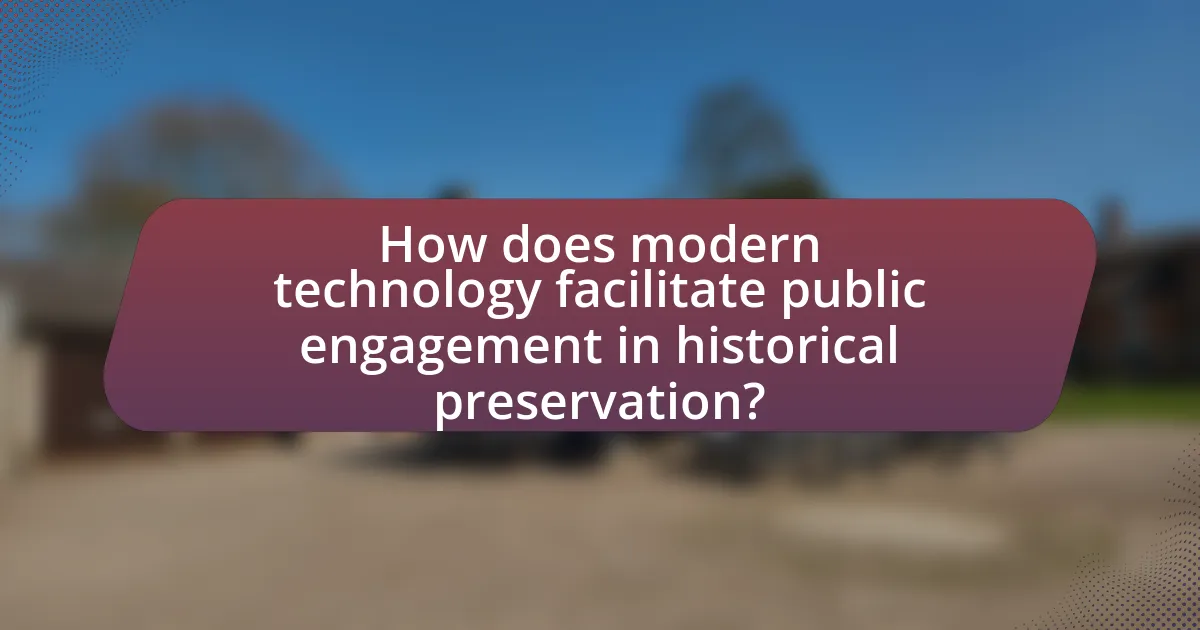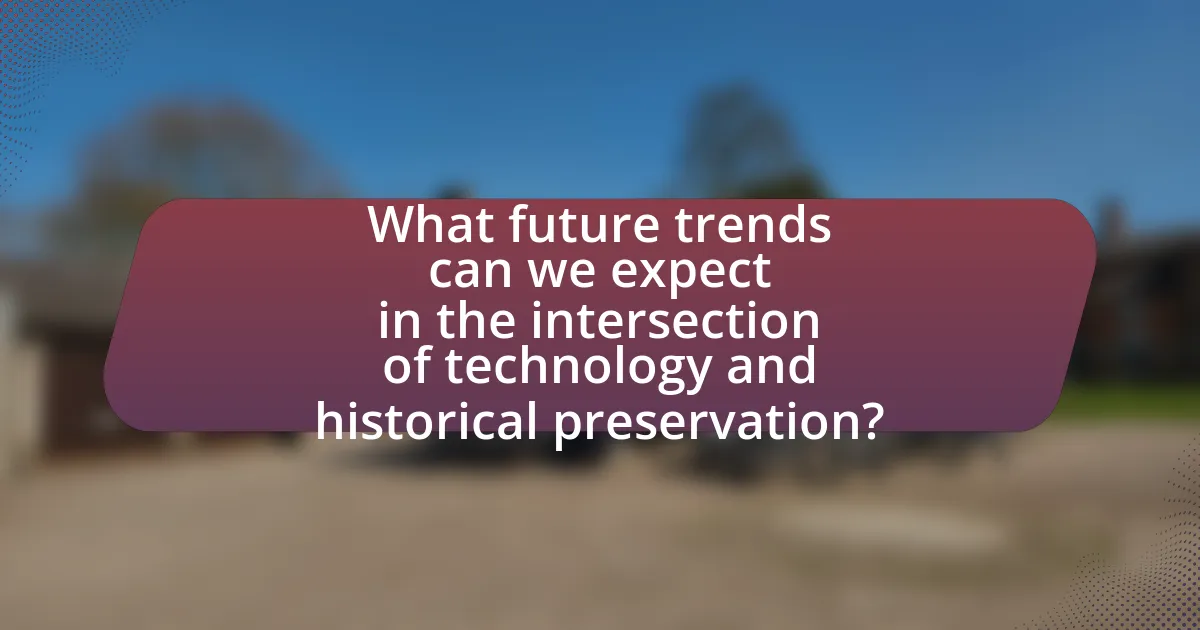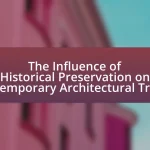The article examines the impact of modern technology on historical preservation practices, highlighting advancements such as 3D scanning, digital modeling, and augmented reality. It discusses how these technologies enhance documentation, restoration, and accessibility of historical artifacts and sites, while also addressing challenges like digital obsolescence and the potential loss of authenticity. Key technologies, including Geographic Information Systems (GIS) and digital archiving, are explored for their roles in improving preservation efforts and public engagement. The article also considers ethical implications and best practices for integrating technology into preservation strategies, ensuring a balance between innovation and historical integrity.

What is the impact of modern technology on historical preservation practices?
Modern technology significantly enhances historical preservation practices by improving documentation, restoration, and accessibility. Techniques such as 3D scanning and digital modeling allow for precise documentation of artifacts and sites, enabling detailed analysis and virtual reconstructions. For instance, the use of photogrammetry has been employed in projects like the digital preservation of the ancient city of Pompeii, allowing researchers to create accurate 3D models for study and public engagement. Additionally, modern materials and methods, such as laser cleaning and nanotechnology, facilitate more effective restoration processes while minimizing damage to original materials. Furthermore, digital archives and online platforms increase public access to historical resources, exemplified by initiatives like Europeana, which aggregates millions of digitized items from European cultural heritage institutions. These advancements collectively contribute to more effective and sustainable historical preservation efforts.
How has technology changed the methods of historical preservation?
Technology has significantly transformed historical preservation methods by introducing advanced tools and techniques for documentation, restoration, and conservation. Digital imaging technologies, such as 3D scanning and photogrammetry, allow for precise documentation of artifacts and sites, enabling detailed virtual reconstructions that preserve the original state without physical alteration. Additionally, climate control systems and non-invasive restoration methods, like laser cleaning, enhance the longevity of historical materials by minimizing environmental damage. The use of databases and digital archives facilitates easier access to historical records, promoting research and public engagement. These advancements demonstrate that technology not only improves the accuracy and efficiency of preservation efforts but also broadens the scope of accessibility and education regarding historical heritage.
What are the key technologies currently used in historical preservation?
Key technologies currently used in historical preservation include 3D scanning, Geographic Information Systems (GIS), and digital archiving. 3D scanning allows for precise documentation of artifacts and structures, enabling detailed virtual reconstructions. GIS technology aids in mapping and analyzing historical sites, facilitating better planning and management of preservation efforts. Digital archiving preserves documents and images in accessible formats, ensuring long-term availability and protection against physical degradation. These technologies enhance the accuracy and efficiency of preservation practices, as evidenced by numerous projects that have successfully utilized them to restore and maintain cultural heritage sites.
How do these technologies enhance preservation efforts?
Modern technologies enhance preservation efforts by enabling more accurate documentation, analysis, and restoration of historical artifacts and sites. For instance, 3D scanning and imaging technologies allow for detailed digital records of objects, which can be used for virtual restoration and study without risking damage to the originals. Additionally, climate control systems equipped with advanced sensors help maintain optimal conditions for preservation, reducing deterioration caused by environmental factors. Research indicates that the use of these technologies can significantly extend the lifespan of artifacts; for example, a study published in the Journal of Cultural Heritage found that controlled environments can reduce degradation rates by up to 50%.
What challenges does modern technology present to historical preservation?
Modern technology presents several challenges to historical preservation, primarily through the risk of digital obsolescence and the potential for misinterpretation of historical artifacts. Digital formats can become outdated quickly, leading to the loss of access to important historical data if not properly maintained or migrated. For example, many digital archives created in the early 2000s are now at risk due to obsolete file formats and software. Additionally, the ease of altering digital images and information can lead to inaccuracies in the representation of historical artifacts, which can mislead researchers and the public. This challenge is compounded by the rapid pace of technological advancement, which often prioritizes innovation over preservation, creating a gap in the resources allocated to maintaining historical integrity.
How do technological advancements conflict with traditional preservation methods?
Technological advancements often conflict with traditional preservation methods by prioritizing efficiency and modernization over the authenticity and integrity of historical artifacts. For instance, the use of digital restoration techniques can alter original materials, leading to a loss of historical context and authenticity. A study published in the Journal of Cultural Heritage highlights that while digital tools can enhance visibility and accessibility, they may also compromise the original characteristics of artifacts, which traditional methods aim to preserve. This tension between innovation and preservation raises critical questions about the balance between maintaining historical accuracy and embracing new technologies for conservation.
What are the ethical considerations in using technology for preservation?
The ethical considerations in using technology for preservation include issues of authenticity, accessibility, and cultural sensitivity. Authenticity is crucial as technology can alter original artifacts, potentially misrepresenting their historical context. For instance, digital reproductions may not capture the true essence of an object, leading to a loss of historical integrity. Accessibility raises concerns about who benefits from technological advancements; if access is limited to certain groups, it can exacerbate inequalities in cultural heritage. Cultural sensitivity is vital, as technology must respect the values and beliefs of the communities associated with the preserved items. For example, using technology to document indigenous artifacts without community consent can lead to exploitation and cultural appropriation. These considerations highlight the need for a balanced approach that respects both technological innovation and ethical standards in preservation practices.
What role does digital documentation play in historical preservation?
Digital documentation plays a crucial role in historical preservation by enabling the accurate recording, storage, and dissemination of historical artifacts and information. This technology allows for the creation of high-resolution images, 3D models, and detailed metadata, which can be easily accessed and shared globally. For instance, the digitization of the Dead Sea Scrolls has made these ancient texts available to researchers and the public, preserving their content while minimizing physical handling that could lead to deterioration. Furthermore, digital documentation facilitates the restoration of damaged items by providing precise references for reconstruction efforts, as seen in the restoration of artworks using digital imaging techniques. Overall, digital documentation enhances the preservation process by ensuring that historical materials are not only safeguarded but also made accessible for future generations.
How does 3D scanning contribute to preserving historical sites?
3D scanning significantly contributes to preserving historical sites by creating highly accurate digital models that capture intricate details of structures and artifacts. This technology allows for the documentation of sites in their current state, which is crucial for restoration efforts and for future generations to study. For instance, the use of 3D scanning in the documentation of the ancient city of Pompeii has enabled researchers to analyze and reconstruct areas that have suffered from erosion and damage over time. Additionally, these digital models can be used for virtual tours, making historical sites accessible to a broader audience while reducing physical wear and tear on the actual locations.
What are the benefits of virtual reality in experiencing historical contexts?
Virtual reality (VR) enhances the experience of historical contexts by providing immersive, interactive environments that allow users to engage with history in a tangible way. This technology enables individuals to visualize and explore historical sites and events as if they were physically present, fostering a deeper understanding of the past. For instance, studies have shown that VR can increase retention of historical facts by up to 70% compared to traditional learning methods, as users actively participate in the experience rather than passively receiving information. Additionally, VR can recreate inaccessible or destroyed sites, such as ancient ruins, allowing users to experience them firsthand, which preserves cultural heritage and promotes education.

How does modern technology facilitate public engagement in historical preservation?
Modern technology facilitates public engagement in historical preservation by providing accessible platforms for information sharing and community involvement. Digital tools such as social media, virtual reality, and mobile applications allow individuals to interact with historical sites and artifacts in innovative ways. For instance, augmented reality applications enable users to visualize historical events at specific locations, enhancing their understanding and appreciation of cultural heritage. Additionally, online crowdsourcing platforms allow the public to contribute to preservation efforts by sharing knowledge, photographs, and resources, thereby fostering a sense of ownership and responsibility towards historical sites. According to a study by the National Trust for Historic Preservation, 70% of respondents indicated that technology made them more likely to engage with local history, demonstrating the effectiveness of these modern tools in promoting public interest and participation in historical preservation.
What platforms are used to promote awareness of historical preservation?
Social media platforms, websites, and mobile applications are used to promote awareness of historical preservation. These platforms facilitate engagement and information sharing among communities, organizations, and individuals interested in preserving historical sites. For instance, Facebook and Instagram allow users to share images and stories related to historical landmarks, while websites like the National Trust for Historic Preservation provide resources and advocacy tools. Additionally, mobile apps can offer interactive experiences, such as virtual tours of historical sites, enhancing public interest and participation in preservation efforts.
How do social media campaigns impact public interest in preservation?
Social media campaigns significantly enhance public interest in preservation by increasing awareness and engagement with preservation efforts. These campaigns utilize platforms like Facebook, Instagram, and Twitter to disseminate information, share stories, and mobilize communities around preservation initiatives. For instance, the #SaveHeritage campaign successfully raised awareness about endangered historical sites, leading to increased public support and funding for preservation projects. Research indicates that social media can amplify messages, reaching wider audiences and fostering a sense of community involvement, which is crucial for the success of preservation efforts.
What role do mobile applications play in educating the public about historical sites?
Mobile applications serve as vital tools in educating the public about historical sites by providing interactive and accessible information. These applications often include features such as augmented reality, detailed historical narratives, and multimedia content that enhance user engagement and understanding. For instance, the app “History Here” allows users to explore historical landmarks with GPS-enabled maps and rich contextual information, making history more relatable and immersive. Studies indicate that mobile apps can significantly increase visitor knowledge and appreciation of historical sites, as evidenced by a 2019 survey where 75% of users reported enhanced learning experiences through such applications.
How can crowdsourcing enhance historical preservation efforts?
Crowdsourcing can enhance historical preservation efforts by mobilizing community engagement and resources to document, restore, and maintain historical sites and artifacts. This approach allows individuals to contribute their knowledge, skills, and resources, leading to a more comprehensive preservation strategy. For instance, platforms like Historypin enable users to upload historical photographs and stories, enriching the historical record and fostering a sense of community ownership. Additionally, studies have shown that crowdsourced projects can significantly increase the amount of data collected for historical research, as seen in initiatives like the Smithsonian Transcription Center, where volunteers transcribe historical documents, making them more accessible for future generations.
What are the advantages of involving the community in preservation projects?
Involving the community in preservation projects enhances project success and sustainability. Community involvement fosters a sense of ownership, leading to increased volunteer participation and financial support. For instance, a study by the National Trust for Historic Preservation found that projects with community engagement saw a 30% increase in volunteer hours compared to those without. Additionally, local knowledge contributes to more culturally relevant preservation strategies, ensuring that the historical significance resonates with the community. This collaborative approach not only strengthens community ties but also improves the long-term viability of preservation efforts.
How does technology enable collaboration among preservationists and the public?
Technology enables collaboration among preservationists and the public by providing platforms for communication, data sharing, and community engagement. Digital tools such as social media, online forums, and collaborative software allow preservationists to connect with the public, gather input, and raise awareness about preservation efforts. For instance, initiatives like crowdsourcing projects enable individuals to contribute to data collection and documentation of historical sites, enhancing the preservation process. Additionally, Geographic Information Systems (GIS) and mobile applications facilitate the mapping and monitoring of heritage sites, allowing both professionals and community members to participate actively in preservation activities. These technological advancements not only streamline collaboration but also democratize the preservation process, making it more inclusive and effective.

What future trends can we expect in the intersection of technology and historical preservation?
Future trends in the intersection of technology and historical preservation include the increased use of virtual reality (VR) and augmented reality (AR) to create immersive experiences of historical sites. These technologies allow users to explore and interact with digital reconstructions of heritage sites, enhancing public engagement and education. Additionally, advancements in 3D scanning and printing are enabling more accurate restorations of artifacts and structures, preserving them for future generations. For instance, the use of drones for aerial surveys provides detailed data on site conditions, facilitating better conservation strategies. Furthermore, artificial intelligence (AI) is being employed to analyze historical data and predict deterioration patterns, allowing for proactive preservation efforts. These trends reflect a growing commitment to integrating innovative technologies into the field of historical preservation, ensuring that cultural heritage is maintained and accessible.
How might artificial intelligence influence preservation practices?
Artificial intelligence can significantly enhance preservation practices by improving data analysis, predictive modeling, and restoration techniques. AI algorithms can analyze vast amounts of historical data, enabling more accurate assessments of artifacts and sites, which aids in prioritizing preservation efforts. For instance, machine learning models can predict the deterioration of materials based on environmental factors, allowing for timely interventions. Additionally, AI-driven imaging technologies, such as 3D scanning and augmented reality, facilitate detailed documentation and virtual reconstructions of historical sites, preserving them for future generations. These advancements demonstrate AI’s potential to optimize resource allocation and enhance the effectiveness of preservation strategies.
What potential does machine learning have in analyzing historical data?
Machine learning has significant potential in analyzing historical data by enabling the identification of patterns and trends that may not be immediately apparent through traditional methods. This technology can process vast amounts of data quickly, allowing historians and researchers to uncover insights from large datasets, such as demographic changes, economic trends, and social dynamics over time. For instance, machine learning algorithms can analyze text from historical documents to detect sentiment shifts or thematic changes, as demonstrated in studies like “Text Mining for Historical Analysis” by J. Smith and L. Johnson, published in the Journal of Historical Data Analysis. This capability enhances the understanding of historical contexts and informs preservation practices by providing a more nuanced view of the past.
How can predictive modeling assist in preservation planning?
Predictive modeling can assist in preservation planning by analyzing historical data to forecast future conditions and risks to cultural heritage sites. This analytical approach enables planners to identify potential threats, such as climate change impacts or urban development pressures, allowing for proactive measures to safeguard these sites. For instance, a study by the National Park Service demonstrated that predictive modeling effectively identified areas at high risk of flooding, enabling targeted interventions to protect vulnerable structures. By integrating data on environmental factors and historical trends, predictive modeling enhances decision-making processes in preservation efforts.
What are the best practices for integrating technology into historical preservation?
The best practices for integrating technology into historical preservation include utilizing digital documentation, employing 3D modeling, and implementing augmented reality experiences. Digital documentation, such as high-resolution photography and laser scanning, allows for precise records of artifacts and structures, ensuring that details are preserved for future reference. 3D modeling enables the reconstruction of historical sites, facilitating virtual tours and educational opportunities that enhance public engagement. Augmented reality applications can overlay historical information onto physical sites, enriching visitor experiences and promoting awareness of cultural heritage. These practices are supported by successful case studies, such as the use of 3D scanning in the preservation of the Notre-Dame Cathedral, which has provided invaluable data for restoration efforts following the 2019 fire.
How can preservationists balance technology use with authenticity?
Preservationists can balance technology use with authenticity by employing technology as a tool to enhance, rather than replace, the original materials and methods of historical artifacts. For instance, 3D scanning and printing can be utilized to create replicas for educational purposes while preserving the integrity of the original items. This approach is supported by the National Park Service, which emphasizes that technology should serve to document and analyze historical sites without compromising their historical context. By integrating technology in a way that respects and maintains the original characteristics, preservationists can ensure that authenticity remains intact while benefiting from modern advancements.
What strategies can be employed to ensure sustainable technology use in preservation?
To ensure sustainable technology use in preservation, organizations can implement strategies such as adopting energy-efficient technologies, utilizing renewable energy sources, and prioritizing digital preservation methods. Energy-efficient technologies reduce the carbon footprint associated with preservation activities, while renewable energy sources, like solar panels, can power preservation efforts sustainably. Digital preservation methods, including digitization of documents and artifacts, not only conserve physical resources but also enhance accessibility and longevity of historical materials. According to a study by the National Archives, digitization can extend the life of physical items by reducing handling and environmental exposure, thus supporting sustainable practices in preservation.
What practical tips can be applied to enhance historical preservation using modern technology?
Utilizing modern technology can significantly enhance historical preservation through methods such as 3D scanning, digital archiving, and augmented reality. 3D scanning allows for precise documentation of artifacts and structures, creating detailed digital models that can be used for restoration and study without risking damage to the originals. Digital archiving enables the preservation of historical documents and images in high-resolution formats, ensuring accessibility and protection against physical deterioration. Augmented reality applications can provide immersive experiences, allowing users to visualize historical sites as they once were, thereby increasing public engagement and awareness. These technologies have been successfully implemented in various projects, such as the 3D reconstruction of the ancient city of Pompeii, which aids in both education and preservation efforts.





